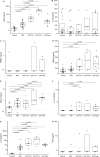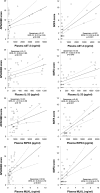Circulating Markers of Necroptosis in Acute Pancreatitis
- PMID: 38940973
- PMCID: PMC11415434
- DOI: 10.1007/s10620-024-08530-6
Circulating Markers of Necroptosis in Acute Pancreatitis
Abstract
Objectives: Necroptosis, a programmed inflammatory cell death, is involved in the pathogenesis of acute pancreatitis (AP). We compared levels of interleukin (IL)-33 (released upon necroptosis), sST2 (soluble IL-33 receptor), MLKL, RIPK1 and RIPK3 (necroptosis executioner proteins), and proinflammatory cytokines IL-6, TNF and IL-1β at various severity categories and stages of AP.
Methods: Plasma from 20 patients with early mild AP (MAP) (symptom onset < 72 h), 7 with severe AP (SAP) without and 4 with persistent organ failure (OF) at sampling, 8 patients with late SAP and 20 healthy controls (HC) were studied by ELISAs.
Results: Early sST2 and IL-6 levels predicted the development of SAP and were higher in both MAP and early and late SAP than in HC. RIPK3 levels were higher than in HC in the patients who had or would later have SAP. MLKL levels were associated with the presence of OFs, particularly in the late phase, but were also higher in MAP than in HC.
Conclusions: sST2, RIPK3 and IL-6 levels may have prognostic value in AP. Elevated MLKL levels are associated with OF in AP. Better understanding of necroptosis in AP pathophysiology is needed to evaluate whether inhibiting and targeting necroptosis is a potential therapeutic option in AP.
Keywords: Acute pancreatitis; MLKL; Necroptosis; Organ failure; RIPK3; sST2.
© 2024. The Author(s).
Conflict of interest statement
The authors have no relevant competing interests to declare.
Figures



Similar articles
-
Circulating necroptosis markers in chronic pancreatitis and pancreatic cancer: Associations with diagnosis and prognostic factors.Pancreatology. 2024 Dec;24(8):1229-1236. doi: 10.1016/j.pan.2024.11.016. Epub 2024 Nov 26. Pancreatology. 2024. PMID: 39613683
-
Serum soluble suppression of tumorigenicity 2 as a novel inflammatory marker predicts the severity of acute pancreatitis.World J Gastroenterol. 2021 Oct 14;27(38):6489-6500. doi: 10.3748/wjg.v27.i38.6489. World J Gastroenterol. 2021. PMID: 34720537 Free PMC article.
-
Necroptosis protects against exacerbation of acute pancreatitis.Cell Death Dis. 2021 Jun 10;12(6):601. doi: 10.1038/s41419-021-03847-w. Cell Death Dis. 2021. PMID: 34112763 Free PMC article.
-
Viral-induced neuronal necroptosis: Detrimental to brain function and regulation by necroptosis inhibitors.Biochem Pharmacol. 2023 Jul;213:115591. doi: 10.1016/j.bcp.2023.115591. Epub 2023 May 16. Biochem Pharmacol. 2023. PMID: 37196683 Review.
-
The Inflammatory Signal Adaptor RIPK3: Functions Beyond Necroptosis.Int Rev Cell Mol Biol. 2017;328:253-275. doi: 10.1016/bs.ircmb.2016.08.007. Epub 2016 Sep 22. Int Rev Cell Mol Biol. 2017. PMID: 28069136 Free PMC article. Review.
References
-
- Banks PA, Bollen TL, Dervenis C et al. Classification of acute pancreatitis–2012: revision of the Atlanta classification and definitions by international consensus. Gut. 2013;62:102–111. 10.1136/gutjnl-2012-302779. - PubMed
-
- Wang G, Qu FZ, Li L, Lv JC, Sun B. Necroptosis: a potential, promising target and switch in acute pancreatitis. Apoptosis. 2016;21:121–129. 10.1007/s10495-015-1192-3. - PubMed
-
- Shlomovitz I, Erlich Z, Speir M et al. Necroptosis directly induces the release of full-length biologically active IL-33 in vitro and in an inflammatory disease model. Febs j. 2019;286:507–522. 10.1111/febs.14738. - PubMed
MeSH terms
Substances
LinkOut - more resources
Full Text Sources
Medical
Research Materials
Miscellaneous

